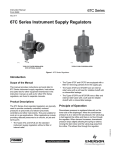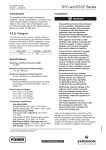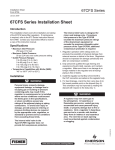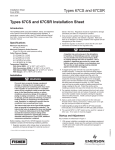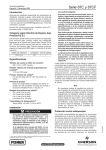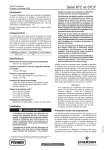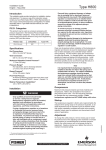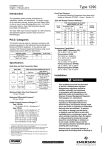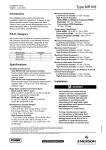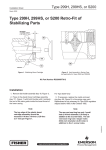Download Emerson 67C Installation Instructions
Transcript
Types 67C and 67CR Installation Sheet Form 5751 March 2009 Types 67C and 67CR Installation Sheet Introduction This Installation Sheet covers the installation and startup of the Types 67C and 67CR instrument supply regulators. If maintenance is required, refer to the 67C Series Instruction Manual, form 5469. Contact your local Sales Office to receive a copy of the instruction manual. Specifications • Maximum Inlet Pressure: 250 psig (17,2 bar) • Maximum Emergency Outlet Pressure: 50 psi (3,5 bar) over outlet pressure setting • Outlet Pressure Ranges: 0 to 20 psig (0 to 1,4 bar) 0 to 35 psig (0 to 2,4 bar) 0 to 60 psig (0 to 4,1 bar) 0 to 125 psig (0 to 8,6 bar) • Temperature Capabilities with Nitrile (NBR): Standard Bolting: -20° to 180°F (-29° to 82°C) Stainless Steel Bolting: -40° to 180°F (-40° to 82°C) Installation ! Warning The internal relief valve in the Type 67CR regulator does not provide full overpressure protection. The internal relief valve is designed for minor seat leakage only. If maximum inlet pressure to the Type 67CR exceeds the maximum pressure ratings of the downstream equipment or exceeds the maximum allowable outlet pressure of the Type 67CR, additional overpressure protection is required. 1. Regulator operation within ratings does not preclude the possibility of physical damage from external sources or debris in the lines. Regulators should be inspected for damage periodically and after an overpressure condition. 2. Only personnel qualified through training and experience should install, operate, and maintain a regulator. Make sure there is no damage to or foreign material in the regulator and all tubing/ piping is free of debris. 3. Install the regulator so that flow is from the IN to the OUT connection as marked on the regulator body. ! Warning A regulator may vent some gas to the atmosphere. In hazardous or flammable gas service, vented gas may accumulate and cause personal injury, death, or property damage due to fire or D103073X012 Personal injury, property damage, equipment damage, or leakage due to escaping gas or bursting of pressure-containing parts may result if this regulator is overpressured or is installed where service conditions could exceed the limits given in the specifications, or where conditions exceed any ratings of the adjacent piping or piping connections. To avoid such injury or damage, provide pressure-relieving or pressure-limiting devices (as required by the appropriate code, regulation, or standard) to prevent service conditions from exceeding those limits. www.emersonprocess.com/regulators Types 67C and 67CR explosion. Vent a regulator in hazardous gas service to a remote, safe location away from air intakes or any hazardous area. The vent line or stack opening must be protected against condensation or clogging. ! 4. A clogged spring case vent hole may cause the regulator to function improperly. To keep this vent hole from being plugged (and to keep the spring case from collecting moisture, corrosive chemicals, or other foreign material) orient the vent to the lowest possible point on the spring case or otherwise protect it. Inspect the vent hole regularly to make sure it is not plugged. Spring case vent hole orientation may be changed by rotating the spring case with respect to the body. A 1/4 NPT spring case vent may be remotely vented by installing tubing or piping into the vent. 5. For regulator shutdown, install upstream block and vent valves and downstream block and vent valves (if required), or provide some other suitable means of properly venting the regulator inlet and outlet pressures. 6. Apply a good grade of pipe compound to the male pipe threads before making connections, making sure not to get the pipe compound inside the regulator. 7. Install tubing fitting or piping into the 1/4 NPT inlet connection on the body (key 1) and into the 1/4 NPT body outlet connection. 8. The second 1/4 NPT outlet can be used for a gauge or other use. If not used, it must be plugged. Startup and Adjustment 1. With proper installation completed and downstream equipment properly adjusted, slowly open the upstream and downstream shutoff valve (when used) while using pressure gauges to monitor pressure. 2 Warning To avoid personal injury, property damage, or equipment damage caused by bursting of pressure containing parts or explosion of accumulated gas, never adjust the control spring to produce an outlet pressure higher than the upper limit of the outlet pressure range for that particular spring. If the desired outlet pressure is not within the range of the control spring, install a spring of the proper range. 2. If outlet pressure adjustment is necessary, monitor outlet pressure with a gauge during the adjustment procedure. The regulator is adjusted by loosening the locknut (key 19), if used, and turning the adjusting screw or handwheel (key 18) clockwise to increase or counterclockwise to decrease the outlet pressure setting. Tighten the locknut to maintain the adjustment position. Parts List Key Description 1 Body 3 Flange Screw 4(1) O-Ring 7 Spring Case 10(1, 2) Valve Cartridge 11(1, 2) Valve Plug 12(1, 2) Valve Spring 13(1, 2) Valve Retainer 14(1, 2) O-Ring 15(1, 2) Relief Valve Soft Seat 16(1) Diaphragm Assembly 17 Spring 18 Adjusting Screw 19 Locknut 20 Upper Spring Seat 39 Bottom Plate 1. Recommended Spare Part 2. Valve cartridge assembly includes keys 10, 11, 12, 13, 14, and 15. Types 67C and 67CR 18 19 7 note 1 20 17 3 16 15 to 30-inch pounds (1,7 to 3,4 n•m) 15 11 outlet inlet 14 1 12 4 10 T40645 13 apply lubricant note: 1. items 25 and 40 should have top edge placed at this level. 3 39 15 to 30-inch pounds (1,7 to 3,4 n•m) Figure 1. 67C Series Assembly soft seat (key 15) valve plug (key 11) valve cartridge (key 10) valve spring (key 12) o-ring (key 14) valve retainer (key 13) B2695 Figure 2. Valve Cartridge Assembly 3 Types 67C and 67CR Industrial Regulators Natural Gas Technologies TESCOM Emerson Process Management Regulator Technologies, Inc. Emerson Process Management Regulator Technologies, Inc. Emerson Process Management Tescom Corporation USA - Headquarters McKinney, Texas 75069-1872 USA Tel: 1-800-558-5853 Outside U.S. 1-972-548-3574 USA - Headquarters McKinney, Texas 75069-1872 USA Tel: 1-800-558-5853 Outside U.S. 1-972-548-3574 USA - Headquarters Elk River, Minnesota 55330-2445 USA Tel: 1-763-241-3238 Asia-Pacific Shanghai, China 201206 Tel: +86 21 2892 9000 Asia-Pacific Singapore, Singapore 128461 Tel: +65 6777 8211 Europe Bologna, Italy 40013 Tel: +39 051 4190611 Europe Bologna, Italy 40013 Tel: +39 051 4190611 Gallardon, France 28320 Tel: +33 (0)2 37 33 47 00 Middle East and Africa Dubai, United Arab Emirates Tel: +971 4811 8100 Europe Selmsdorf, Germany 23923 Tel: +49 (0) 38823 31 0 For further information visit www.emersonprocess.com/regulators The Emerson logo is a trademark and service mark of Emerson Electric Co. All other marks are the property of their prospective owners. Fisher is a mark owned by Fisher Controls, Inc., a business of Emerson Process Management. The contents of this publication are presented for informational purposes only, and while every effort has been made to ensure their accuracy, they are not to be construed as warranties or guarantees, express or implied, regarding the products or services described herein or their use or applicability. We reserve the right to modify or improve the designs or specifications of such products at any time without notice. Emerson Process Management does not assume responsibility for the selection, use or maintenance of any product. Responsibility for proper selection, use and maintenance of any Emerson Process Management product remains solely with the purchaser. ©Emerson Process Management Regulator Technologies, Inc., 2002, 2009; All Rights Reserved




